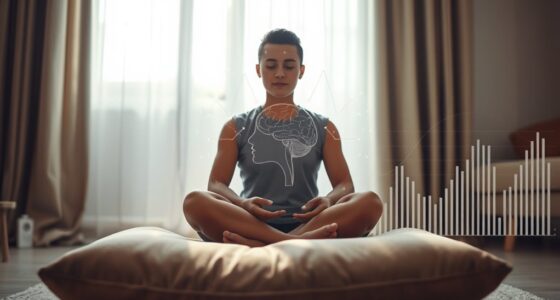Taking a digital detox helps you restore focus and find calm by giving your mind a break from constant notifications and screen time. It reduces stress, prevents burnout, and improves mental clarity. Setting boundaries, like unplugging during meals or before bed, boosts your emotional well-being and strengthens real-world relationships. Regularly disconnecting supports mindfulness and prevents overwhelm. If you want to learn simple strategies to create lasting balance, keep exploring ways to unplug and recharge.
Key Takeaways
- A digital detox reduces screen time and notifications, helping to lower stress and prevent overwhelm.
- Unplugging fosters mindfulness, self-reflection, and mental clarity, restoring focus and emotional balance.
- Setting boundaries, like tech-free zones and scheduled breaks, supports healthier device use and improves calmness.
- Regular digital detoxes enhance cognitive function, creativity, and problem-solving by providing mental downtime.
- Disconnecting from technology strengthens real-world relationships and promotes genuine human connections.
Understanding the Need for a Digital Break

In today’s hyperconnected world, taking a digital break has become essential for maintaining mental and emotional well-being. Constant exposure to screens and notifications can overwhelm your mind, leading to fatigue, stress, and emotional exhaustion. Digital overload makes it hard to focus, process emotions, or enjoy genuine connections. Many people feel the pressure to stay constantly available, which increases anxiety and reduces overall happiness. Recognizing the need for a break helps you regain control over your attention and mental space. Stepping away from digital devices allows for reflection, mindfulness, and a sense of calm. It’s not about abandoning technology but creating healthy boundaries that protect your mental health and restore your capacity for focus, emotional regulation, and meaningful human interaction. Implementing a digital detox can also support your overall lifestyle by promoting better work-life balance and reducing burnout.
Psychological and Cognitive Benefits of Unplugging

When you unplug, you can improve your emotional regulation and handle stress more effectively. It also encourages mindfulness and self-reflection, helping you gain clarity and perspective. Additionally, taking digital breaks can restore your cognitive capacity, making it easier to focus and think clearly. Practicing meditation during these breaks can further enhance your mental clarity and emotional stability, fostering a deeper sense of mindfulness.
Enhanced Emotional Regulation
Unplugging from digital devices can considerably enhance your emotional regulation by reducing the constant influx of stimuli that often overwhelm your mind. When you disconnect, you create space to process emotions calmly and respond thoughtfully, rather than react impulsively. This break helps you build resilience against stress and emotional triggers, fostering stability. During detox, you become more aware of your feelings and patterns, enabling better management of mood swings and anxiety. Incorporating activities like riding an electric dirt bike can also promote mindfulness and physical well-being, further supporting emotional balance.
Increased Mindfulness and Reflection
Digital detox encourages you to pause and reflect, fostering greater mindfulness of your digital habits and emotional state. When you disconnect, you gain space to observe how technology influences your mood and thoughts without distraction. This awareness helps you identify patterns of compulsive use and triggers for stress or anxiety. As you step back from screens, you become more present, cultivating a sense of calm and clarity. Reflection during detox periods allows you to question your relationship with technology and set healthier boundaries. Over time, this mindful awareness supports the development of sustainable habits, reducing impulsive digital behaviors. Engaging in digital well-being practices can further enhance your ability to manage screen time effectively. By intentionally unplugging, you create opportunities for deeper self-understanding, emotional regulation, and a more balanced approach to technology in your daily life.
Restored Cognitive Capacity
Taking regular breaks from screens can considerably restore your cognitive capacity, helping you think more clearly and focus better. When you disconnect, your brain gets a chance to reset from constant multitasking and information overload. This mental downtime enhances your attention span and problem-solving skills, making it easier to process complex ideas. Digital detox reduces cognitive fatigue caused by persistent notifications and digital distractions. As you step away from devices, your mind can reorganize thoughts and improve memory retention. You also regain mental agility, allowing for more creative thinking and better decision-making. Additionally, contrast ratio plays a role in how well your brain perceives visual information, which can influence overall mental clarity. Over time, these breaks help strengthen your overall cognitive resilience, so your mind feels sharper, more focused, and less overwhelmed in daily life.
Current Trends and Demographics of Digital Detoxing

As of 2025, about 20% of people worldwide actively participate in some form of digital detox, reflecting growing awareness of the mental health risks associated with constant screen time. Young adults aged 25–34, men, and those with postgraduate education are most likely to engage in detox efforts. Strategies vary: 37% delete apps, 35% take short breaks, 27% limit device use, 24% disable notifications, and 23% remove phones from bedrooms. Despite increased awareness, overall screen time remains high due to tech’s integration into work and daily life. Rising concerns about tech addiction and mental health drive interest in detoxing, even as many struggle to reduce digital engagement. Demographic differences suggest tailored approaches to promote healthier digital habits and address specific needs.
Impact of Overuse on Social Connections and Well-Being

Overuse of technology considerably reduces in-person social interactions, leading to weaker personal connections and feelings of social isolation. When you’re glued to screens, you miss out on meaningful face-to-face conversations, making relationships feel superficial or strained. This digital dependency can cause loneliness, even when you’re technically connected online. Family dynamics also shift as differing attitudes toward tech create misunderstandings or emotional distance. Despite the convenience of online platforms, many adults and younger generations still prefer in-person contact for deeper bonding. To counteract this, try practices like phone-free meals or setting aside specific times for face-to-face meetings. These intentional efforts help strengthen your real-world connections and improve overall well-being, reducing feelings of loneliness and social disconnection. Additionally, understanding beneficiary designation rules can help ensure your relationships are protected and your social estate remains aligned with your intentions.
Strategies for Effective Digital Detox in Daily Life and Work

To effectively incorporate digital detox into your daily life and work routines, you need practical strategies that create clear boundaries and foster mindful technology use. Start by scheduling designated tech-free periods, like during meals or an hour before bed. Turn off non-essential notifications to reduce distractions, and set specific times to check emails and social media. Use apps or device settings to limit screen time on apps that drain your focus. Establish physical boundaries, such as keeping phones out of bedrooms or workspaces, and designate tech-free zones. Incorporate mindful practices like brief meditation or deep breathing to reconnect with the present moment. Regularly assess your digital habits, adjusting boundaries as needed to maintain balance and prevent burnout. Additionally, implementing digital boundaries helps reinforce healthy habits and avoid overuse. Consistency is key to making these strategies effective long-term.
Building a Sustainable Balance Between Technology and Well-Being

Achieving a sustainable balance between technology use and well-being requires deliberate effort and ongoing adjustment. You need to set clear boundaries, like designated tech-free zones or specific times to disconnect. Prioritize quality interactions over constant connectivity, focusing on face-to-face conversations and meaningful activities. Incorporate regular digital detoxes to reset your mental bandwidth and reflect on your tech habits. Be mindful of your device use—recognize triggers that lead to overuse and develop healthier routines. Adjust your approach based on your changing needs, such as work demands or personal goals. Remember, balance isn’t static; it’s a dynamic process that involves continuous awareness and refinement to support your mental, emotional, and social health. For some, workaholic relationship struggles can impact their ability to disconnect, making it even more essential to establish boundaries and prioritize self-care.
Frequently Asked Questions
How Long Should a Typical Digital Detox Last for Optimal Benefits?
You should aim for a digital detox lasting at least a few days to see meaningful benefits, especially for mental health and cognitive clarity. Shorter breaks, like a weekend or a week, allow you to reset digital habits, reduce stress, and foster mindfulness. Longer detoxes can deepen these effects, but consistency over time matters most. Tailor the length to your needs, and consider gradual reintroduction to sustain healthier tech use.
Are There Specific Apps or Tools to Help Facilitate Digital Detox?
Think of apps and tools as your digital lighthouse guiding you through foggy tech waters. You can use ScreenTime or Digital Wellbeing to monitor and limit usage, while app blockers like Freedom or StayFocusd cut distractions. Notifications management tools help silence interruptions, and mindfulness apps like Headspace support your mental clarity. These tools act as anchors, helping you stay grounded and committed during your digital detox journey.
Can Digital Detoxing Improve Mental Health in Clinical Populations?
Yes, digital detoxing can improve mental health in clinical populations. You might find that taking intentional breaks from digital devices reduces depressive symptoms, enhances emotional control, and fosters mindfulness. By limiting screen time and engaging in reflection, you can better manage anxiety and stress. Tailoring detox strategies to your specific needs and mental health conditions helps maximize benefits, supporting recovery and overall well-being.
How Does Digital Detox Impact Sleep Quality and Circadian Rhythms?
You might think scrolling late into the night helps you unwind, but digital detox actually improves your sleep quality and resets your circadian rhythms. By unplugging, you reduce blue light exposure, which suppresses melatonin. Imagine your brain finally getting the message that it’s bedtime, not a constant digital party. So, putting down your devices before sleep isn’t just old advice—it’s a health hack that helps you wake up refreshed and in sync with your natural rhythms.
What Are Common Challenges Faced When Maintaining a Digital Detox Routine?
You might struggle with maintaining a digital detox because of habitual device use and fear of missing out. Distractions, social pressure, and work demands can tempt you back online. You may also feel anxious or lonely without digital connection, making it hard to stick to your routine. To overcome these challenges, set clear boundaries, create tech-free zones, and find alternative activities that keep you engaged and connected offline.
Conclusion
Taking time to gently unplug isn’t just about stepping away from screens; it’s about giving yourself space to breathe, reconnect, and find your calm. By weaving small moments of digital quiet into your day, you create a welcoming environment for your mind and heart to flourish. Remember, a little digital downtime can refresh your outlook and strengthen your connections—so go ahead, embrace those peaceful pauses and enjoy the renewed clarity they bring.









